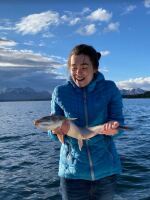Moose season opened last week around Dillingham and to the north, and hunting starts Wednesday around Togiak. From Lake Iliamna down to Katmai Preserve the season starts Sept. 1. As hunters gear up for fall moose, biologists look to population fluctuations across Bristol Bay.
Fall hunting is underway in Bristol Bay.
Moose season opened Friday around Dillingham and to the north, in units 17B and C. That will run through Sept. 15.
The moose hunt around Togiak, in 17A, begins on Wednesday and ends Sept. 25. Residents can harvest a bull or an antlerless moose.
Dillingham's area management biologist, Bryan Reiley, said the moose around Togiak continue to be prolific.

“So much so that we have the fall hunt, but we also have a winter hunt, and there’s even an antlerless moose hunt there,” Reiley said.
While moose in units B and C are still in good shape, Reiley said he and other biologists are concerned about calf survival, which has taken a dip.
The decline is not about food, Reiley said; he saw a decent number of cows with triplets this year.
“Which means that they’re getting enough food, that they’re doing well," he said. "It’s just a matter of how many of them are surviving. We have less than 10% survival, which is quite low.”
This spring, Fish and Game put radio collars on about 60 calves to track them and monitor their survival. Reiley said that showed that many are being eaten by bears.
Meanwhile, some moose populations are down in Unit 9, which starts above Lake Iliamna and extends along the Alaska Peninsula.
But there are areas with enough moose to hold a hunt for bulls, said Fish and Game Management Biologist Dave Crowley in King Salmon.
“Primarily in 9C and 9 E. But we also have moose in 9B," he said. "That’s Lake Iliamna, Kukaklik Lake area, the Katmai Preserve are all open to moose hunting.”

The preserve is in the northern part of Unit 9C, and there are also state and federal lands open to hunting to the west of Katmai National Park.
The season opens Sept. 1 for units B and C. Further south, down in unit 9E, the season opens Sept. 10.
Crowley said the population is doing well, and the ratio of moose calves to cows has been up as well, after a dip that lasted nearly a decade.
“In recent years we’re up over 20 -- even up towards 30 calves per hundred cows. So good production, good survival, and I’m hoping our harvest comes up a little bit this year,” he said.
The bag limit is one bull. Unit 9E bulls have antler restrictions -- with antlers at least 50 inches wide or spike-forked, and at least three brow tines on one side.
Caribou herds to the south are doing well, Crowley said. There are 300 permits for a limited hunt on the Northern Alaska Peninsula Caribou herd. There is a harvest ticket hunt for the southern herd; residents can bag up to three caribou.
To the west, caribou are not an option. The state has issued just eight permits for the Nushagak Peninsula caribou herd. And hunting for the Mulchatna herd is closed on both state and federal lands.
Four hunting permits went to the Manokotak Village Council, and the Dillingham and Aleknagik Village Councils received two permits each. Those will be distributed by the Tribal councils.
Fall moose hunting for residents in units 9 and 17
Unit 9A: Sept. 1 - 15
Residents can take one bull under RM271.
Units 9B and 9C: Sept. 1 - 20
Residents can take one bull under RM272.
Unit 9E: Sept. 10 - 25
Residents can take one bull with with antlers at least 50 inches wide or spike-forked, and at least three brow tines on one side.
17A: Aug. 25 - Sept. 25
Residents can take one bull under RM573 or one antlerless moose under RM571. Permits are available in Dillingham and Togiak.
17B and 17C: Aug. 20 - Sept. 15, Sept. 1 - 15
Residents can take one bull under the RM 583 hunt. Starting on Sept. 1, they can take one bull with spike-fork antlers, antlers at least 50 inches wide, or antlers with at least three brow tines on at least one side.
Contact the author at izzy@kdlg.org or 907-842-2200.



